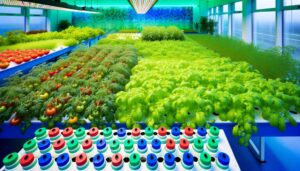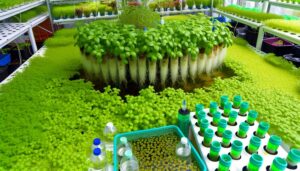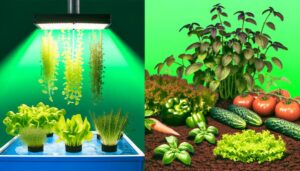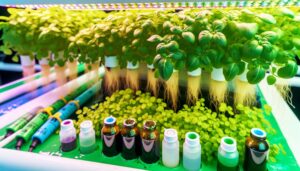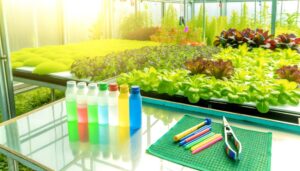Nutrients Needed to Grow Hydroponic Weed
Growing hydroponic weed necessitates a balanced supply of macronutrients and micronutrients for ideal development. Key macronutrients include nitrogen (N), phosphorus (P), and potassium (K), which are essential for vegetative growth, energy transfer, and osmotic regulation, respectively.
Important micronutrients such as calcium, magnesium, and iron support cell wall stability, chlorophyll synthesis, and electron transport. Proper nutrient ratios, e.g., 3-1-2 for vegetative stages and 1-3-4 for flowering, are critical.
Identifying deficiency symptoms, like yellowing leaves for nitrogen shortage, is significant for timely interventions. Explore the nuances of nutrient optimization and systematic monitoring to maximize yield and quality of hydroponic cannabis.
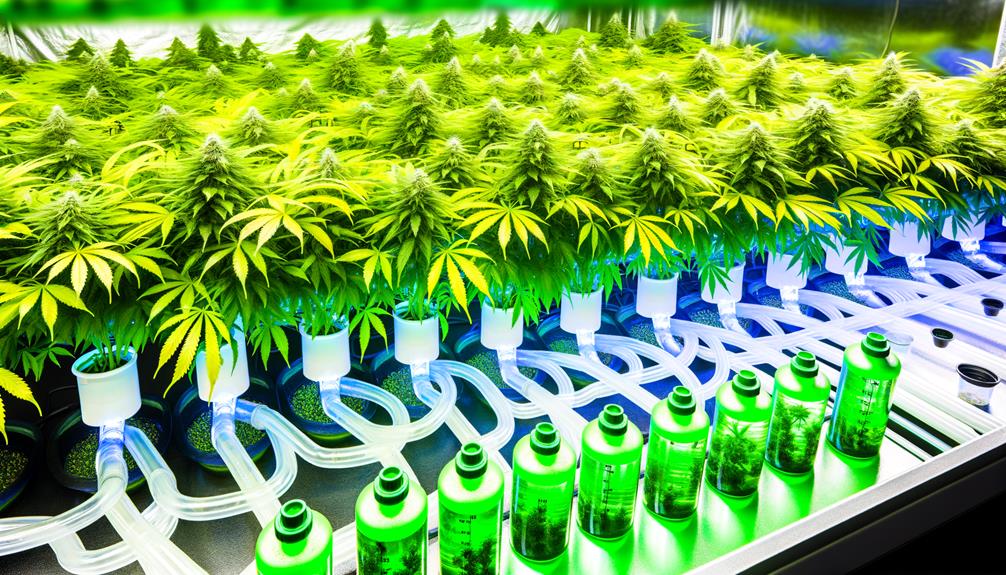
Key Takeaways
- Essential nutrients include nitrogen (N), phosphorus (P), and potassium (K) for optimal growth and yield.
- Key micronutrients like calcium, magnesium, and iron support overall plant health and development.
- Nitrogen is crucial during vegetative growth, while phosphorus and potassium are vital during the flowering stage.
- Recommended N-P-K ratios: 3-1-2 for vegetative phase, 1-3-4 for flowering phase to ensure balanced growth.
Macronutrients for Hydroponic Weed
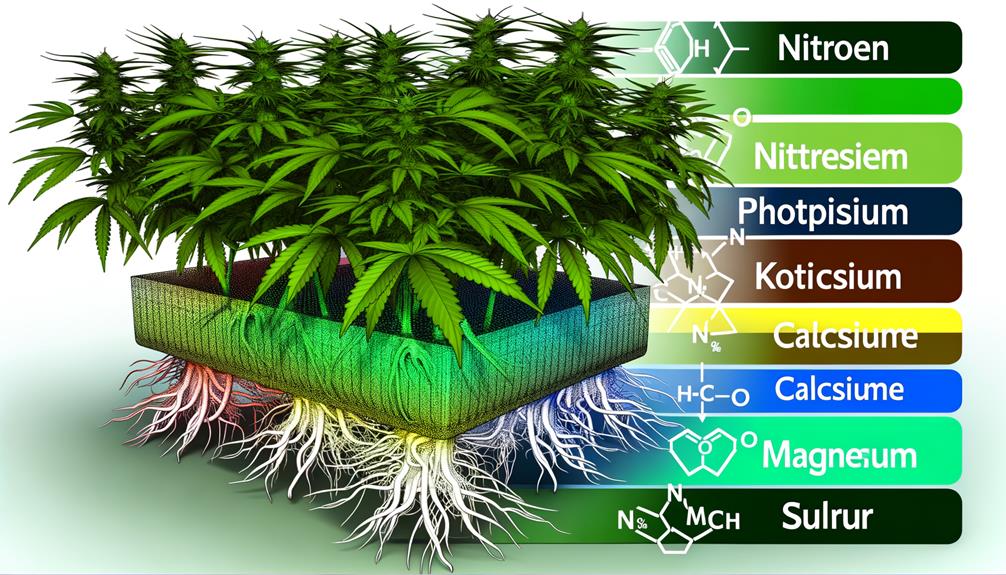
Macronutrients, including nitrogen (N), phosphorus (P), and potassium (K), are essential for the ideal growth and development of hydroponic cannabis.
Nitrogen is vital for vegetative growth, playing an important role in chlorophyll production and amino acid synthesis.
Phosphorus is indispensable during the flowering stage, aiding in energy transfer through ADP and ATP, and fostering robust root development.
Potassium contributes to overall plant health by regulating osmotic balance, enzyme activation, and photosynthesis.
Empirical studies have established that ideal concentrations of N, P, and K in hydroponic systems greatly enhance yield and cannabinoid profile.
Precise nutrient management, including monitoring Electrical Conductivity (EC) and pH levels, is crucial to guarantee these macronutrients are bioavailable and effectively utilized by the cannabis plants.
Key Micronutrients
In addition to macronutrients, key micronutrients such as calcium, magnesium, and iron are essential for the ideal growth and physiological functioning of hydroponic cannabis.
Calcium aids in cell wall stability and root development, while magnesium is a central component of chlorophyll, facilitating photosynthesis. Iron is vital for electron transport in photosynthesis and respiration.
Deficiencies in these micronutrients can lead to symptoms such as chlorosis, stunted growth, and reduced yield.
Empirical studies demonstrate that precise micronutrient management directly correlates with optimal plant health and productivity.
Utilizing chelated forms of these elements can enhance their bioavailability in hydroponic systems, ensuring efficient uptake and utilization by cannabis plants.
Proper monitoring and adjustment of micronutrient levels are imperative for successful cultivation.
Balancing Nutrient Ratios
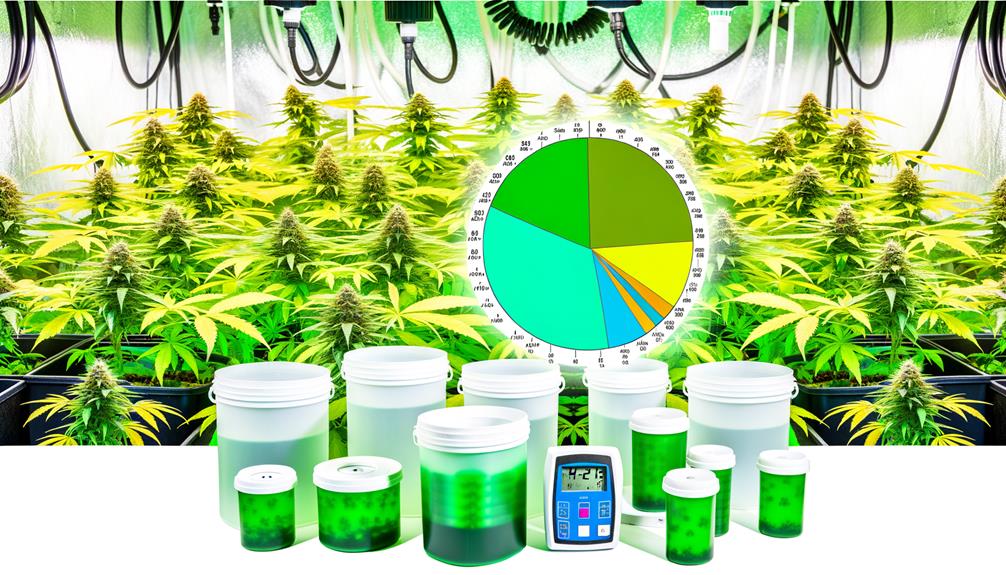
Achieving ideal growth in hydroponic cannabis cultivation necessitates meticulously balancing nutrient ratios to guarantee each element is available in the correct proportions for the plant's various developmental stages.
Proper nutrient management involves understanding the specific needs of cannabis during vegetative and flowering phases. For instance, a higher nitrogen concentration is vital during the vegetative stage to support robust leaf growth, while increased phosphorus and potassium levels are essential during flowering to enhance bud development and potency.
Evidence-based hydroponic solutions often recommend an N-P-K (Nitrogen-Phosphorus-Potassium) ratio of 3-1-2 for vegetative growth, shifting to 1-3-4 in flowering.
Continuous monitoring of nutrient solutions and adjusting ratios based on plant responses is key to avoid imbalances that can impede growth.
Nutrient Deficiency Signs
Recognizing nutrient deficiency signs is essential for maintaining ideal health and maximizing yield in hydroponic cannabis cultivation.
Deficiencies manifest in specific symptoms: nitrogen deficiency typically results in yellowing leaves starting from the base, while phosphorus deficiency is indicated by dark, purplish foliage and stunted growth.
Potassium deficit often shows in yellowing leaf edges and brown, necrotic spots. Calcium deficiency can cause distorted new growth and weakened stems. Magnesium shortage is evidenced by interveinal chlorosis, starting on older leaves.
Each deficiency affects plant physiology and growth, necessitating prompt correction. Regular monitoring and leaf tissue analysis can provide early detection, allowing for targeted nutrient adjustments to sustain robust plant development and optimize crop yields.
Best Nutrient Solutions
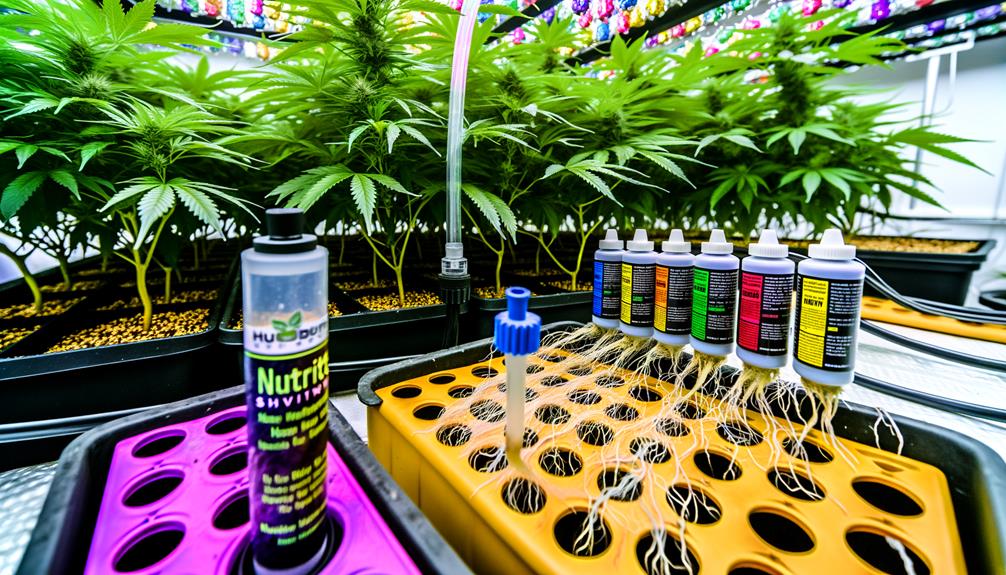
Selecting the best nutrient solutions is fundamental to addressing deficiencies and guaranteeing ideal growth in hydroponic cannabis systems. Optimal nutrient solutions are tailored to the specific growth stages of cannabis, enhancing both vegetative and flowering phases.
Evidence-based research underscores the importance of a balanced nutrient mix to prevent issues like nutrient lockout and deficiencies. Here are critical considerations for selecting nutrient solutions:
- Macro and Micronutrient Balance: Confirm the solution contains essential elements like nitrogen, phosphorus, potassium, and trace minerals.
- pH Stability: Choose solutions that maintain a stable pH range between 5.5 and 6.5.
- Bioavailability: Opt for chelated nutrients for improved plant uptake.
Conclusion
In the intricate dance of hydroponic cannabis cultivation, the precise orchestration of macronutrients, micronutrients, and balanced nutrient ratios forms the lifeblood of thriving plants.
Vigilant monitoring for deficiency signs acts as the sentinel, ensuring ideal growth.
Employing the best nutrient solutions, supported by evidence-based practices, cultivates a verdant canopy teeming with vigor.
This symphony of nutrients underscores the crucial importance of a meticulously controlled environment for achieving unparalleled cultivation success. By ensuring optimal pH levels and precise nutrient ratios, growers can maximize plant health and yield potential. It is essential to mix hydroponic nutrients correctly to prevent deficiencies or imbalances that could hinder growth. A well-regulated system fosters robust root development and enhances nutrient uptake, leading to thriving plants.

